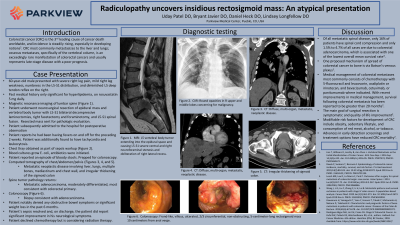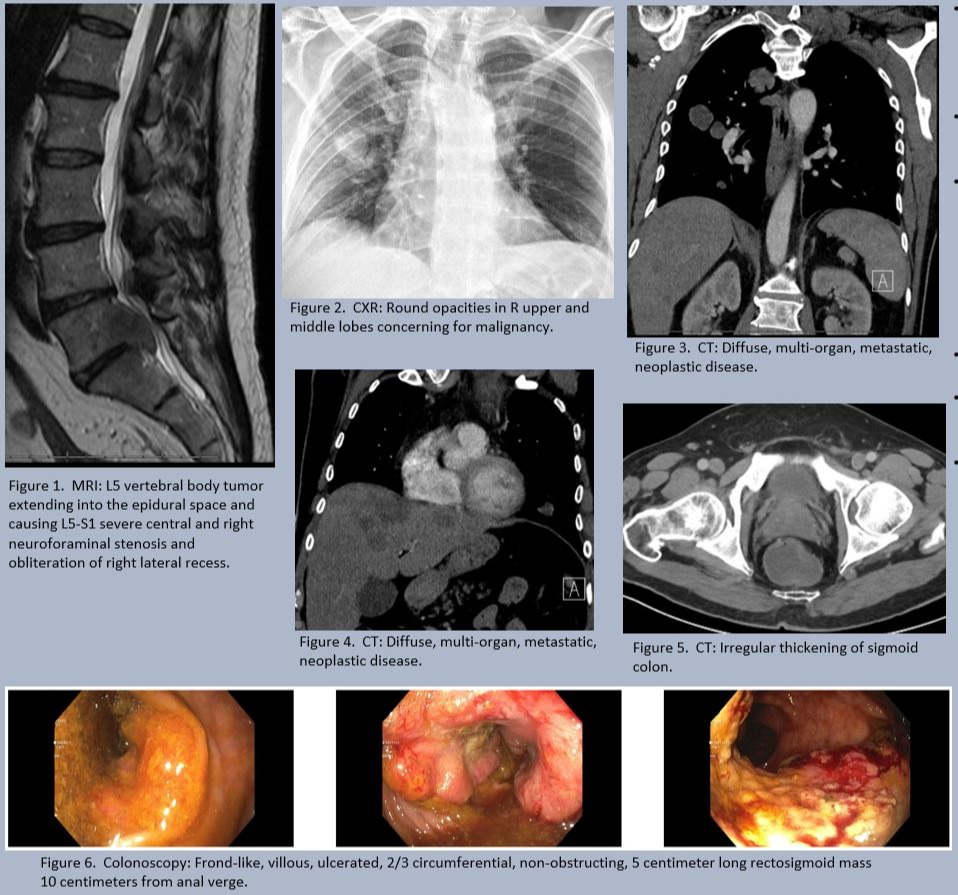Tuesday Poster Session
Category: Colon
P3073 - Radiculopathy Uncovers Insidious Rectosigmoid Mass: An Atypical Presentation
Tuesday, October 24, 2023
10:30 AM - 4:00 PM PT
Location: Exhibit Hall

Has Audio
- UP
Uday Patel, DO
Parkview Medical Center
Pueblo, CO
Presenting Author(s)
Uday Patel, DO, Bryant Pinto. Javier, DO, MHA, Daniel Heck, DO, Lindsey Longfellow, DO
Parkview Medical Center, Pueblo, CO
Introduction: Colorectal cancer (CRC) is the 3rd leading cause of cancer death worldwide, and incidence is steadily rising, especially in developing nations. CRC most commonly metastasizes to the liver and lungs; osseous metastases, specifically of the vertebral column, is an exceedingly rare manifestation of colorectal cancers and usually represents late-stage disease with poor prognosis.
Case Description/Methods: A 60-year-old male presented with severe right leg pain, weakness, numbness and diminished relexes in the L5-S1 distribution. MRI revealed L5 vertebral body tumor causing severe central and neuroforaminal compression at L5-S1. Patient underwent neurosurgical resection of mass and was admitted to the hospital for postoperative observation, where he reported that he had been having fevers on and off for the preceding 2 weeks. Patient additionally reported an episode of bloody stools that same evening and began bowel preparation for colonoscopy the following morning. CT imaging revealed extensive metastatic disease involving liver, lungs, multiple bones, mediastinum and chest wall, and irregular thickening of the sigmoid colon. Spine tumor pathology returned showing metastatic adenocarcinoma most consistent with colorectal primary. Colonoscopy revealed frond-like, villous, ulcerated, 2/3 circumferential, rectosigmoid mass, for which biopsy was consistent adenocarcinoma. Patient notably denied any prior obstructive bowel symptoms or significant weight loss. Patient declined chemotherapy, but is considering radiation therapy. On discharge, the patient did report significant improvement in his neurological symptoms.
Discussion: Of all metastatic spinal disease, only 16% of patients have spinal cord compression and only 1.5% to 4.7% of all cases are due to colorectal adenocarcinoma, which is associated with one of the lowest overall mean survival rate. Medical management of colorectal metastases most commonly consists of chemotherapy with 5-fluorouracil and leucovorin, oxaliplatin or irinotecan, and bevacizumab, cetuximab, or panitumumab where indicated. With recent improvements in medical management, survival following colorectal metastasis has been reported to be greater than 20 months. The main goal of surgical resection is symptomatic and quality of life improvement. Modifiable risk factors for development of CRC include obesity, sedentary lifestyle, and consumption of red meat, alcohol, or tobacco. Advances in early detection screenings and treatment options have reduced CRC mortality.

Disclosures:
Uday Patel, DO, Bryant Pinto. Javier, DO, MHA, Daniel Heck, DO, Lindsey Longfellow, DO. P3073 - Radiculopathy Uncovers Insidious Rectosigmoid Mass: An Atypical Presentation, ACG 2023 Annual Scientific Meeting Abstracts. Vancouver, BC, Canada: American College of Gastroenterology.
Parkview Medical Center, Pueblo, CO
Introduction: Colorectal cancer (CRC) is the 3rd leading cause of cancer death worldwide, and incidence is steadily rising, especially in developing nations. CRC most commonly metastasizes to the liver and lungs; osseous metastases, specifically of the vertebral column, is an exceedingly rare manifestation of colorectal cancers and usually represents late-stage disease with poor prognosis.
Case Description/Methods: A 60-year-old male presented with severe right leg pain, weakness, numbness and diminished relexes in the L5-S1 distribution. MRI revealed L5 vertebral body tumor causing severe central and neuroforaminal compression at L5-S1. Patient underwent neurosurgical resection of mass and was admitted to the hospital for postoperative observation, where he reported that he had been having fevers on and off for the preceding 2 weeks. Patient additionally reported an episode of bloody stools that same evening and began bowel preparation for colonoscopy the following morning. CT imaging revealed extensive metastatic disease involving liver, lungs, multiple bones, mediastinum and chest wall, and irregular thickening of the sigmoid colon. Spine tumor pathology returned showing metastatic adenocarcinoma most consistent with colorectal primary. Colonoscopy revealed frond-like, villous, ulcerated, 2/3 circumferential, rectosigmoid mass, for which biopsy was consistent adenocarcinoma. Patient notably denied any prior obstructive bowel symptoms or significant weight loss. Patient declined chemotherapy, but is considering radiation therapy. On discharge, the patient did report significant improvement in his neurological symptoms.
Discussion: Of all metastatic spinal disease, only 16% of patients have spinal cord compression and only 1.5% to 4.7% of all cases are due to colorectal adenocarcinoma, which is associated with one of the lowest overall mean survival rate. Medical management of colorectal metastases most commonly consists of chemotherapy with 5-fluorouracil and leucovorin, oxaliplatin or irinotecan, and bevacizumab, cetuximab, or panitumumab where indicated. With recent improvements in medical management, survival following colorectal metastasis has been reported to be greater than 20 months. The main goal of surgical resection is symptomatic and quality of life improvement. Modifiable risk factors for development of CRC include obesity, sedentary lifestyle, and consumption of red meat, alcohol, or tobacco. Advances in early detection screenings and treatment options have reduced CRC mortality.

Figure: CRC Mets Imaging
Disclosures:
Uday Patel indicated no relevant financial relationships.
Bryant Javier indicated no relevant financial relationships.
Daniel Heck indicated no relevant financial relationships.
Lindsey Longfellow indicated no relevant financial relationships.
Uday Patel, DO, Bryant Pinto. Javier, DO, MHA, Daniel Heck, DO, Lindsey Longfellow, DO. P3073 - Radiculopathy Uncovers Insidious Rectosigmoid Mass: An Atypical Presentation, ACG 2023 Annual Scientific Meeting Abstracts. Vancouver, BC, Canada: American College of Gastroenterology.
